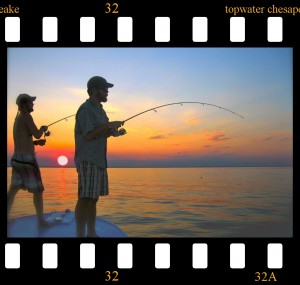 Lights! Action! Intensity! Get those video camera’s rolling. It’s time for adrenaline pumping surface action along the rocky shorelines and the grassy points of the Chesapeake Bay. The top-water bite is on! I’ve written a lot about where and when to cast top-water lures, but I haven’t said too much about choosing a good fishing rod for surface feeding stripers. Let’s fix that. Here are six tips for choosing the right top-water rod.
Lights! Action! Intensity! Get those video camera’s rolling. It’s time for adrenaline pumping surface action along the rocky shorelines and the grassy points of the Chesapeake Bay. The top-water bite is on! I’ve written a lot about where and when to cast top-water lures, but I haven’t said too much about choosing a good fishing rod for surface feeding stripers. Let’s fix that. Here are six tips for choosing the right top-water rod.
1. Spin It To Win It – Since it’s often windy on the Bay and surface lures are light and not very aerodynamic, I prefer a spinning outfit for top-water casting. There’s a trade off because casting rods are more accurate, but there’s nothing more frustrating than having to stop to pick out a backlash, especially while you’re drifting quickly past fish-holding cover. If need be, you can increase your accuracy with a spinning outfit by adding micro-guides, but standard guides work fine. Reduce your margin for error and go with the sissy stick.
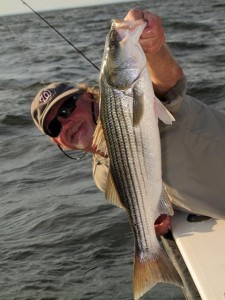 2. Forget Sensitivity – You don’t need a highly- sensitive rod for casting surface lures because you usually see the strike, but you do need a rod that will maximize your chances of catching and landing a big fish. Take sensitivity out of the equation when making your choice.
2. Forget Sensitivity – You don’t need a highly- sensitive rod for casting surface lures because you usually see the strike, but you do need a rod that will maximize your chances of catching and landing a big fish. Take sensitivity out of the equation when making your choice.
3. The Shorter the Sweeter – While a longer rod might help you cast farther, a shorter one will let you put more action into your lures. This is especially important if you like throwing walk-the-dog type lures called spooks, or unweighted soft plastics. To get the best action out of a spook, you need to point your rod tip toward the water and twitch slightly left and right. A short rod gives you more room to maneuver. It also allows shorter twitches so you get a tighter wobble out of your lures and you can fish them slower. I suggest a 6′ 6″ rod for top-water stripers.
4. Slow ‘er Down – Conventional bass-fishing wisdom says fast rods are better for top-water because the stiff tip allows you to deliver action to your lure quicker. Striper fishing is somewhat different because the fish often miss the lure on the first strike or two. Go with a rod with a slower tip because this will slightly delay your reaction and increase your hook sets. Don’t get a rod that’s too slow though, because that makes it a lot harder to walk a spook or twitch a popper. Moderate or moderate fast action rods are my choice for Chesapeake stripers. Don’t forget to wait for the weight before setting the hook. In other words, improve your blow up to hook up ratio by allowing the fish to load up the rod before you jerk.
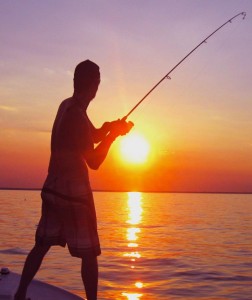 5. Power Up – Unlike jigging when you’re usually in open water, stripers will often take a surface lure in and around cover such as fallen trees and rocks. You sometimes need a little more power to muscle them out. Don’t get carried away though, because a rod that is too heavy will compromise the action to you lures. Medium heavy is the best choice.
5. Power Up – Unlike jigging when you’re usually in open water, stripers will often take a surface lure in and around cover such as fallen trees and rocks. You sometimes need a little more power to muscle them out. Don’t get carried away though, because a rod that is too heavy will compromise the action to you lures. Medium heavy is the best choice.
6. Accessorize – Pair your rod with a quality spinning reel equipped with a smooth dependable drag. A 2500 series is the right size. A reel with a faster retrieve lets you turn the handle less between lure pops, but a slower gear ratio increases hook sets and lands more fish. Remember, with top-water, think slow. For the same reason, spool your top-water outfit with 10- to 15-pound-test monofilament line (I use 12-) and tie on a 25-pound-test leader. Avoid snaps, swivels, or other terminal tackle. A fish thrashing on the surface is a lot more likely to throw a lure, so you need the stretch that monofilament provides to let the fish dive once it gets hooked. Mono also slows down your hook sets. That’s a good thing since it’s almost impossible not to jerk the lure out of a big fishes mouth when it explodes on your lure.
Summary: My recommendation is a 6’6″ medium heavy, moderate fast spinning rod equipped with a moderate retrieve 2500 series reel and 12-pound test monofilament line. There’s more information including an entire chapter devoted to top-water fishing in my book, Chesapeake Light Tackle, An Introduction to Light Tackle Fishing on the Chesapeake Bay.
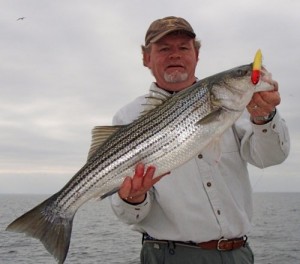 Fishing Report: There are stripers in the rivers now around grassy or rocky points where the current is strong and the fish have a quick escape route to deeper water. Low light situations are best. Don’t be afraid to cast right up to the bank. Spooks are out-fishing poppers except on windy days. Jigging is still very good at the Bay Bridge and picking up along the channel edges in the Upper Bay. The live-lining fleet is working three primary locations: The ledge at Podickory Point, the northwest corner of Poplar Island, or The Bay Bridge pilings. There are small breaking fish all along the west side of Kent Island from Bloody Point to Love Point, bigger breakers on the west side of the channel below Thomas Point. I’ve found a few fish on underwater ledges around 21-feet deep, but they’re less likely now since fish are feeding shallow. Perch fishing is good in the shallows using small flies or spinners or try a 1/8th ounce jig head and small Gulp twister tail to increase your chances for trout and reds. Bluefish are still slow but there are a few schools of snappers around Sharp’s Island.
Fishing Report: There are stripers in the rivers now around grassy or rocky points where the current is strong and the fish have a quick escape route to deeper water. Low light situations are best. Don’t be afraid to cast right up to the bank. Spooks are out-fishing poppers except on windy days. Jigging is still very good at the Bay Bridge and picking up along the channel edges in the Upper Bay. The live-lining fleet is working three primary locations: The ledge at Podickory Point, the northwest corner of Poplar Island, or The Bay Bridge pilings. There are small breaking fish all along the west side of Kent Island from Bloody Point to Love Point, bigger breakers on the west side of the channel below Thomas Point. I’ve found a few fish on underwater ledges around 21-feet deep, but they’re less likely now since fish are feeding shallow. Perch fishing is good in the shallows using small flies or spinners or try a 1/8th ounce jig head and small Gulp twister tail to increase your chances for trout and reds. Bluefish are still slow but there are a few schools of snappers around Sharp’s Island.
Speckled trout fishing is very good on the Eastern Shore south of Taylor’s Island and down through the Tangier into Virginia. I’ve yet to get down that way yet, but all reports are positive with routine catches of trophy specks. An occasional trout or redfish is showing up around Poplar and Kent Island, and I’ve even heard of a few caught accidentally near Rock Hall. Good luck fishing!




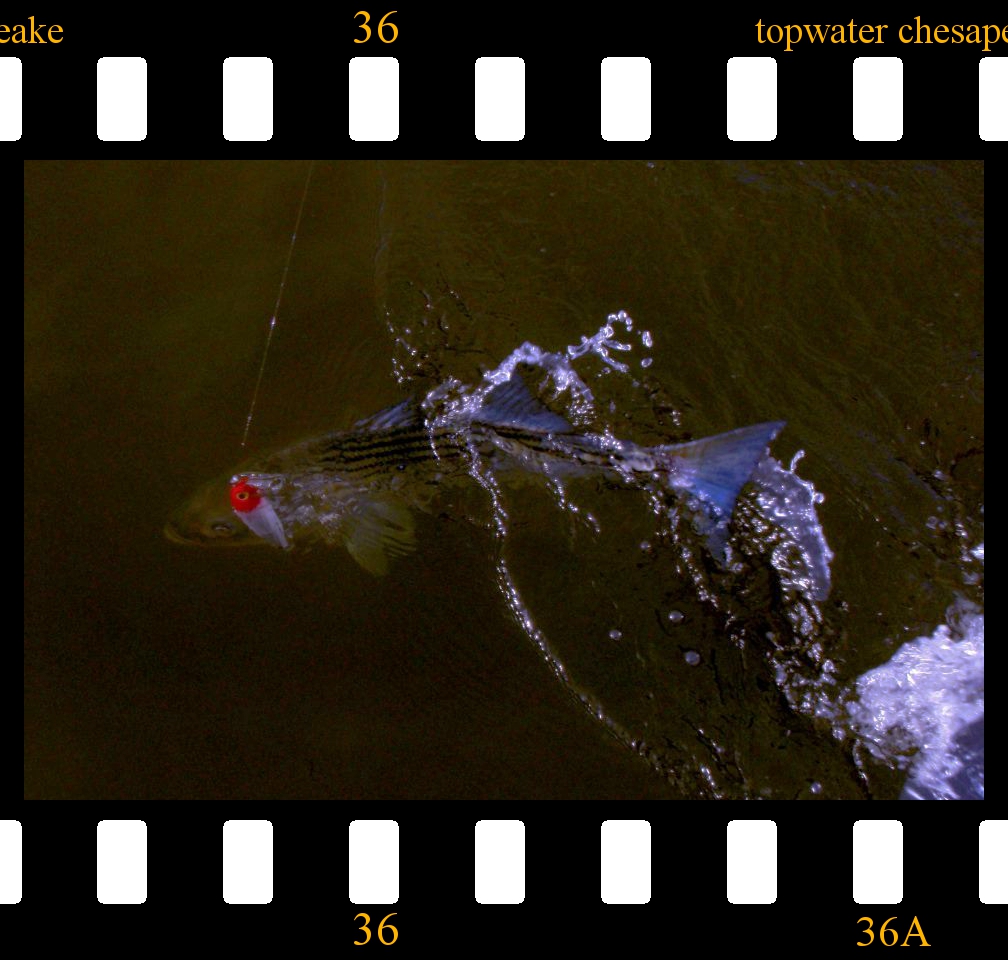
Thanks for the article Shawn. Don’t sleep on throwing topwater for specks either…I had a near citation speck blow up a spook last week on my second cast….a thing of beauty!
THanks, Mike. Know you’re right. I got a 32-inch red on topwater a little farther south recently.
Shawn,
ill send you a pm of a new spot i found, were crushed them yesterday morning.
anway my rod i have been using for poppers is a 7 foot medium power fast action saint croix tidemaster with a Shimano Stradic 3000 and 15 pound power pro
The rod i have been using for walk the dog type lures is a 7 foot Medium light power Fast action Saint Croix mojo inshore with a shimano stradic 3000 and 15 pound braid.
ive tried using mono for topwater but it has resulted in about 5 or 6 lost plugs when breaking while casting, and it wears me out because i have to jerk move to get the lure to move.
IM sure mono is better however because it stretches so you might not lure any fish but for now at least, i like braid.
oh and the only popper ive been using is a mirrolure popa dog and the walk the dog lure is a mirrolure top dog
Congrats, Andrew. Sounds like you have a winning combination.
Great read.Nothing better than Top water.I picked up some interesting Acrylic through wired Top Water plugs wile in Hawaii,going to try them out very soon.
How about the excellent fishing we are seeing right now.So many quality fish in the UB and beyond.
Shawn- As always Thx for the tips and report.
Let us know how those plugs work out, Roger. Yeah, it’s been a good summer so far.